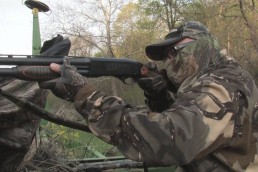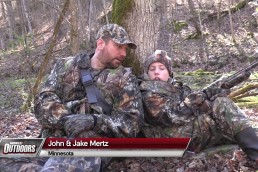Study Spring Gobblers for more Hunting Success
SHARE THIS POST
To tag a spring gobbler, a hunter must have a better understanding of the lifestyle of the mating tom, including knowing why it does what it does in the spring or why it gobbles. Toms create these boisterous vocals to alert hens where they are. We believe these “gobbles” also help sexually intense toms alert other males of their intentions. Much of what humans try to clarify can be a guessing game, but it’s logical that the gobbling is used for the purposes of fending off other toms, and attracting the hens.
Dominant spring gobblers are breeding machines, and toms in March are designed for this. They pursue their roles with zest and intention, but aren’t selective with hens. They’ll mate with any hen that accepts their advances.
But why do they sometimes run right to you?
It might be a mature tom that’s had limited contact with hens or the beginning of breeding season when many hens are in the breeding mood. There are many factors to sort out for hunting strategies. One must be observant, cautious and study the landscape and, above all, recognize how the turkeys are acting.
The birds shy away from hunters and sneak around. Using caution keeps a turkey alive. Their instincts force them to be skeptical of any sound or physical landscape feature that is different from the day before. Male turkey activities vary throughout the year, but what spring hunters should understand is how gobblers live during pre- and post-mating.
How gobblers spend their days this season is vital information for understanding the various ways of hunting this species. Turkeys prefer to roost in trees overnight, and this aerial perch provides them improved security from predators and enables them to view the landscape for danger, especially before they fly down at first light. We must remember that spring gobblers alter their habits, and breeding in spring motivates toms and their activities now reflect this hormonal drive. They are intent upon breeding as many hens as possible, and cover many acres searching for breed-ready hens. They fight with interloping males, and feed, rest and travel like a vagabond as they look for and then gobble to attract any available hen. Just because a tom hangs out across one 80-yard hardwood ridge top area doesn’t mean he won’t travel elsewhere. Logic tells us that if a gobbler has hens available, he hasn’t any reason to move on. But if he can find hens elsewhere too, the testosterone-filled gobbler will travel frequently to breed.
Are you enjoying this post?
You can be among the first to get the latest info on where to go, what to use and how to use it!
Toms select habitats that suite their needs, and can remain within that one expansive landscape area. In spring, their activities are based upon hen availability. Find the hens and the gobblers will be close by. Also, as their bodies change, so do their intentions. They feed aggressively prior to breeding and intensify the size of the breast sponge on their chests. This layer of fatty tissue helps toms sustain their infrequent feeding throughout the lengthy breeding intensity. A tom that has been harvested the first week of legal season will show a larger breast sponge than one shot the last week of season. These early-season toms haven’t reduced their breast sponge capacity.
The most exciting aspect of spring gobblers is when they gobbler, strut or spit and drum. A summer or winter tom cares nothing about these actions because hens aren’t in breed mode. But, when “love is in he air,” they gobble to attract the hens and expect hens to come. So when we call to a spring gobbler, we’re trying to make him do the opposite of what he’s genetically programmed to do. He might stand in the middle of an open pasture strutting and gobbling at calls, but he wants you to go to him, and not every tom will react this way. But he believes he’s the boss and he likes to control hens. If a hen is ready to mate, she will go to him and tease him with intensity before she submits into a breeding posture. But not all hens act the same, and gobblers soon learn that sometimes they must go to a hen, giving a call-hunter an advantage. Turkeys are very patient and will play out a hen until the last few minutes. But if hunters are very patient, they can also eventually tease a tom into a slow approach close enough for a shot.
A savvy turkey studies their opponent and learns intimately what toms do as much as what the hens do in a spring mating cycle. They often congregate in separate sexual flocks. They will roost all together in the trees too. But springtime gobblers especially try to roost as close as possible to the hens. This way they can watch the hens as they pitch to the ground at dawn and be close to them for a possible mating time.
Hens can be the leverage hunters need to tag a tom now too. Hens definitely set the pace of action because their movements drive toms in their direction. Fickle ones will lead toms throughout various landscape features. A tom will gobble, strut and tag by a hen’s side for hours at a time. He can try every trick he can conjure up to put her in a breeding posture. But if she’s not ready, he will either continue with her or just fade away and look for another hen. This is why hunters must focus constantly on hen activities during the breeding cycle. But we must also remember that we’re hunting the toms, not the hens. And hens can and will intervene any time and ruin your hunt. Try to always be one step ahead of a hen. This is why we rely upon a hen’s vocals during the spring because gobblers pursue them and usually shy away from other toms.
A more detailed understanding of the spring gobbler will help you defeat him. Hunter knowledge of their actions is the foundation for successes. Although turkeys often act and react differently, they’re still male, and know that their main role in life is to breed hens for a new generation of poults.
MWO
SHARE THIS POST
Did you enjoy this post?
You can be among the first to get the latest info on where to go, what to use and how to use it!
Bob Grewell
Bob “Greenie” Grewell has written about and photographed the outdoors for 40 years. He’s travelled throughout the U.S., Canada, the Arctic Circle, as well as Germany and Denmark. He has written a book on hunting dogs and contributed articles and photography to others. He currently focuses on deer and turkey articles, and wildlife photography.



